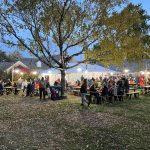Arts & Culture
Girlyman at Shank Hall
How do you know you’ve made it as an Indie-Gender-Folk-Pop group? Is it playing to a crowd that sings along to almost every one of your songs? Witnessing members of your audience placing the now ubiquitous concert calls to friends who couldn’t make it to show? Or is it being called back to the stage, not once but twice, for encores? On Friday night, Girlyman had all of this and more as they played for an enthusiastic crowd at Shank Hall. Before they took the stage, their long-time friend Adrianne played an opening set comprised of original songs that were both well written and well performed. She did play one cover in a nod to the “music of her youth” – the song she referred to as her Cheesy Embarrassing Eighties Favorite, the Thompson Twins’ classic “Hold Me Now.” She won over the cheese-heads and closed her performance by saying, “I’ve only played in Milwaukee a few times and every time it’s been cool. And tonight is infinitely cool!” Girlyman echoed Adrianne’s sentiments by saying repeatedly, “People are nice here!” It’s not hard to be nice to a band that is as humble as it is talented. The three members of Girlyman – Nate Borofsky, Doris Muramatsu and Ty Greenstein – played their own brand of folk music and told the crowd stories about their lives. The setlist consisted mostly of songs from their April release, Joyous Sign, with a smattering of material from their first two albums and a couple of numbers thrown in to make the audience laugh. They cut up onstage to an impromptu “tuning song:” as Ty worked to get her guitar ready for the next number, Nate and Doris sang what started as a schmaltzy ballad and ended with an overstated and hilarious chorus of “We’re not going to tune it/No, we ain’t gonna tune it” to the melody of the old Twisted Sister song. A particular standout from the new album was “Reva Thereafter,” written by all three band members to help Nate work through his grief following the death of his grandmother. Before the song, Nate told the audience a little about her and eloquently painted a picture of a strong, determined woman who took her own life at 95 years old. “You wrote the letters one by one into the setting of the sun/Tell me, what was it like to send yourself into the light that night?” When he openly sang of his pain, we could feel it with him. Isn’t that the ultimate goal of most songwriters? To make your listener feel? As the members of Girlyman interacted with each other and with the audience, we all became invested in the stories that they told in each song. Doris’s profession that her optimism inspired “Good Enough” (“Somewhere back in time we made each other laugh / And I could see how that was good enough”) was sincere and heartfelt, and Ty’s confession that ”Hey Rose” is about a dark period of […]
Oct 1st, 2007 by Vital ArchivesThe Music Issue
Here at VITAL, we love music, and we figure it’s a pretty fair bet that you love music, too. Every year we showcase everything that thrills us about the wide world of melody and harmony, rhythm and tempo, sound and silence, and this year it’s even more close to our hearts — it’s 100% homegrown. We talked to Milwaukee folk singers, Milwaukee hip-hop artists, Milwaukee legends, Milwaukee upstarts, and one remarkable Milwaukee rock photographer. We talked to five Milwaukee DJs about their best and worst nights and we talked to Milwaukee record collectors about the history of recorded music. We even visited the Wisconsin Conservatory of Music for a photo shoot. And our record reviews were local — we reviewed new releases by The Cocksmiths, The Saltshakers, Testa Rosa and Element Everest. It happened rather by accident, but what emerged from all of this was a sketch of an often misunderstood — and underestimated — music scene. Milwaukee is home to a vibrant, striving and passionate community of music lovers, makers and sharers. A lot of it happens under the surface, but it’s there, pulsing and singing and getting people up on their feet. But it’s there. And it’s here in our pages, and on our website. We hope you like it.
Oct 1st, 2007 by Vital ArchivesSharon Jones & the Dap-Kings
They spend all of their free time lending their considerable talents to other people’s work, which makes one wonder how Sharon Jones and her backing band, the Dap-Kings, have had any time for themselves. Jones recently worked with Rufus Wainwright; the Dap-Kings can be heard tearing up pop radio as the backing band on Amy Winehouse’s smash “Rehab.” Yet along comes 100 Days, 100 Nights, their third release, on their own Daptone imprint. Expending all that energy on other projects hasn’t diminished the drive to create on their own; 100 Days sizzles with the classic Motown soul of Aretha and Stevie. While the Dap-Kings’ work on Winehouse’s Back to Black carries a distinctly pop sheen, 100 Days takes wood stripper to that glossy finish, leaving behind raw trumpets, gritty rhythms and the classic two-beat guitar stabs from Motor City faves like one-time Kings’ cover “Uptight (Everything’s Alright).” The lazily upbeat “Tell Me” comes closest to what would have been considered a pop hit in the days of Martha and the Vandellas, but that’s not to say that the midtempo groove that dominates the album won’t get asses on the floor. Of course, the real star here is Jones and her bluesy, ballsy alto, which wails away on tracks like the reproachful “When the Other Foot Drops, Uncle.” Maybe she isn’t likely to become the household name that Winehouse and Lily Allen are on their way to becoming. But since Jones and her band are bringing home plenty of green via their extracurriculars, Amy and Lily are welcome to their celebrity; just occasionally leave this crew to their own devices, and if they keep turning out records like 100 Days, 100 Nights, everyone wins.
Oct 1st, 2007 by DJ HostettlerThe Big Dig
“It swings between passion and obsession, constantly. It’s definitely at the point where I’m like, ‘do I want to buy groceries this week, or do I want to go digging in Indianapolis?’” Aaron Soma spends 12 to 16 hours a week, on average, digging for vinyl. At least once a month, he leaves the state to rummage through basements and backrooms for dusty jewels of sound. He calls it the “great nerd odyssey” – and he’s not being flip, despite the shadow of cool that has settled on record culture in recent years. Aaron can describe what he’s into – Northern soul, forgotten originals of ‘80s pop songs – but it’s hard to put a finger on what he’s really searching for. So in consideration of the question, he made a list, went to some record shops, and thought about it for a while. Here are four things he managed to sort out. 1. Covers, or forgotten originals of songs that were covered and became hits Aaron’s first digs were through his parent’s formidable collection of records. “I picked up Beatles albums,” he says, “wondering, looking at the records, noticing that the song wasn’t written by John Lennon or Paul McCartney, but some American R&B artist somewhere.” “That’s the really exciting thing about collecting,” says Andy Noble, co-owner of LotusLand Records. “You’re always following a path, and you’re probably following multiple paths.” “It could take you back to the beginning of recorded time – or to Africa, or to Brazil – just by following the sound, the producer, the people who were thanked in the liner notes, weird stuff like that. It’s an exploration.” Aaron is always learning; every dig is a research project. “I’ll bring a battery-powered portable record player with me to a shop and just dig through, set stuff aside. That’s how I teach myself what’s going on. I hardly ever know what I’m looking for when I go out: it’s really a dive into the unknown.” 2. Midwestern music Aaron’s serious collecting started with ‘60s psychedelic rock, especially local acts – Michael and the Messengers, The Illusion, The Legends. For the past two or three years, he’s been collecting mainly funk and soul music, and still turns up a lot of local material. “Because I dig regionally, I tend to come up with a decent amount of stuff that was actually happening here – Harvey Scales and the Seven Sounds, The Esquires.” On a sunny late-summer afternoon, Aaron drives me out to an empty storefront on North Avenue. Audie’s Records has been closed since the late ‘80s, and judging from the steamrollers parked next door, it might not be standing for much longer. It used to be a major distribution hub for hip hop, soul and funk in the Midwest. “A lot of that stuff is still here. In bigger Midwest cities – St. Louis, Detroit, Minneapolis – a lot of the shops get really picked through.” Still, good finds don’t come easy – especially with […]
Oct 1st, 2007 by Amy ElliottBuffalo
Affordable drinks and public smoking are two things homesick MC Lunaversol9, recent San Francisco implant, misses most about Milwaukee. Another is, of course, the people—not limited to her newfound friend and cohort Nicholas Sanborn. Sanborn, who frequented the coffeehouse where Luna worked, was familiar with her background with local hip-hop mainstays Def Harmonic, and presented her with an instrumental track in need of her flair. Though unable to produce anything for months, Luna eventually found the words, and the results were “Curtains,” a song about loss that would become one of her favorites to perform solo. “Deer Tracks,” where Luna’s smoke-ridden voice begs “I want antlers” the way a spoiled child demands her own golden goose, began as a looped guitar sample and was presented by Sanborn and verbally delivered by Luna in a similar fashion. “It was strange,” she says. “Unlike any other track I had ever been given. But gorgeous.” After two personally challenging and fulfilling songs, not committing to a project with Sanborn would have been foolish. At Sanborn’s request, the two formed Buffalo; Luna covers most of the lyrics, singing, and rapping, while Sanborn lays down the Wurlitzer, organ, piano, bass, guitar, and computer. “He is a musical genius, and I am mainly just a writer,” Luna admits. “There is really nothing he cannot do; his arrangements and choices are baffling. I only write when I can, and hope it fits.” Her unpretentiously earthy, soul-sopped attitude also bleeds out of her lyrics: “Is there a way to be a writer/And still be in love? Is there a way to drown in water/While watching it from above?” A short-lived, albeit intense fling last summer—evidence to support Luna’s rhetorical questions—was inspiration for the lion’s share of Buffalo’s first album. The debut has been recorded and is currently being mixed, but has no due date. While creative undergoings are usually compared to one’s children, Luna says music has always been more like a parent, much like the city she left to pursue life on the West Coast, a choice partner Sanborn respects and understands. Her goals for Buffalo, even after migrating from the Great Plains, are simply “to continue.” She adds, “to tour would be paradise.” Inspired by Fiona Apple, Tom Waits, Cocorosie, and David Byrne, among others, Luna has her eyes toward indie trip-hops TV On The Radio for tourmates. On March 3, 2007, the newly born Buffalo was unveiled to an audience. Live, the band is a different animal, when a drummer and an additional multi-instrumentalist fill out the stage. Despite Buffalo’s infancy, Luna has rapped since 1999 and Sanborn has played keys for Decibully since 2003, tallying volumes of stage and touring experience. The next Buffalo show, slated for her October Milwaukee homecoming, is promised to provide precisely “what you need at the time.” Luna’s own first impressions of Buffalo—strange and gorgeous—are likely to be yours, too. Two tracks are available for listen at http://www.myspace.com/iwantantlers
Oct 1st, 2007 by Amber HerzogThe Doo-Wop Box
I spent my teen years in Kansas City during the ’50s, and like other suburban girls of my era, gloried in wearing Mamie bangs and pony tails, Poodle skirts and saddle oxfords. A few years ago I bought a pair of those famous black and white shoes with pink rubber soles, copies of the originals which are still being churned out in California. Hey nonny ding-dong. Thank heavens, some things never change. Doo-wop. Do you remember doo-wop, the music of the 50s and 60s, rooted in the urban streets and hearts and souls of black Americans? When The Chords, five black guys, cut “Sh-Boom” in the spring of 1954, I was a senior in high school. My best friend introduced me to the sound, a sound so black that the beat stuck in my head and feet for years. To my lily-white ears it had a dangerous edge that signaled freedom and something other than the privileged “Pleasantville” suburbia of my teen years. It was sexy and sweet and heartbreaking. Filled with tears, moons and stars, it addressed the yearnings of most teenagers, but come to think of it, didn’t actually guarantee any answers to our prayers. In many ways, doo-wop resembled a stone-hearted God that we worshipped on a daily basis. Today I’m sitting in my office writing and listening to The Doo-Wop Box, 101 vocal group tunes compiled in 1993 by Rhino. The four CDs cover the years from 1948 to the doo-wop revival era stretching from 1959-1987. Included is a smart book stuffed with black and white photographs, historical information, and a list of 33 “nonsense” syllables, used to replace traditional instrumentation. Can you identify #17: doo wop, doo wadda, or #31: wah wah, shoop shoop? Along the way, I noticed that many of the vocal groups from the early years were named after birds … The Orioles, The Ravens, The Flamingos, The Wrens, The Penguins. But there were also groups named: The Nutmegs, The Jewels, and The Valentines. These folks did not lack for imagination. In 1956, I floated off to a college dance, in a strapless turquoise tulle gown and huge rhinestone earrings, my hair sheared off in a “Duck’s Ass.” It was a daring haircut, but my date, an uptight dental student intent on fixing tooth decay, never asked me out again, even though we sipped rum and Cokes and danced to “In The Still Of The Nite.” The Five Satins recorded the tune in a basement, and the book in my Doo-Wop Box informs me that despite the hollow sounds, it was one of the two most popular oldies of all times. The other was The Penguins, “Earth Angel.” Their name came from the icon on the Kools cigarettes pack. Earth Angel, earth angel, won’t you be mine? Tonite. Tonite, may never reach an end. Long Lonely Nights by Lee Andrews & The Hearts set my heart on fire. It still does. So, what’s an old lady like me doing listening to doo-wop, […]
Oct 1st, 2007 by Judith Ann MoriartySondre Lerche
When writer/director Peter Hedges (What’s Eating Gilbert Grape? and Pieces of April) first sought out Norweigan popster Sondre Lerche to compose and produce the soundtrack for his film Dan In Real Life, he had no inkling that the artist he so admired was so green, age-wise. Hedges only knew that organic, folky quality of the 25-year-old pop prodigy’s music reminded him of the soundtracks to The Graduate (Simon and Garfunkel) and Harold and Maude (Cat Stevens). Ultimately, Lerche’s age wasn’t a deterrent to Hedges – it ended up highlighting Lerche’s enthusiasm and his hopeful, earnestly-voiced lyrics, adding a lighthearted tone to a film about a single father of three caught in a bizarre love triangle. Lerche’s contributions to Dan In Real Life line up properly, playing into the first initial hope of a new relationship with the sparklingly optimistic “To Be Surprised,” loaded with bubbly guitars and a cheerful admonition: “baby, better be prepared to be surprised.” From there, the songs are sandwiched with mini-instrumentals of guitars, horns and piano, smoothing hope into rough pessimism. On his have-it-out fight song with a charming appearance by Regina Spektor (“Hell No”), Lerche and Spektor ham it up in true “Baby, It’s Cold Outside” call-and-response style. In “I’ll Be OK,” Lerche unloads a cautious, surrendering piece of pop vaudeville, reminiscent of a baggage-victim pouring out the contents of his heart over something strong, hoping that if the people at the bar pay him no mind, at least the alcohol will treat him kindly. A Lerche-produced version of the classic “Fever” performed by A Fine Frenzy escalates the lounge shtick, but Lerche eases back into his own take on classic vintage pop. He finishes up proper “Human Hands,” a bouncy piano romp; a cover of Pete Townshend’s “Let My Love Open the Door” (complete with trill–y strings); and a song from Lerche’s 2001 release Faces Down – “Modern Nature.” Lerche demonstrates on this soundtrack that not only can he deliver the sound he was originally sought out for, but he can deliver it in a manner that gives a deeper and more far-reaching humanity to the original story.
Oct 1st, 2007 by Erin WolfThe Sadies
The Sadies play like a Quentin Tarantino film — a synthesis of cult genres (surf, rockabilly, psychedelia), characters with memorable names (Sean Dean, Dallas Good) wearing smart suits, and a sweeping casualness about it all. Unlike Tarantino, the Toronto band’s fifth studio release has an absence of curse words and racial slurs. It’s hard to neglect their liner-note acknowledgment of the “financial assistance of the government of Canada through the department of Canadian Heritage” – pretty amusing since their brand is a blend of mindfully resuscitated ’60s American music. The Sadies haven’t reinvented the wheel, but they do hitch it on a wagon that rolls past an enjoyable landscape. “My Heart Of Wood” and “Sunset To Dawn” parade natural harmonies reminiscent of the Eagles. “Anna Leigh,” an organ-permeated trot about a mirage of love, is easily mistaken for a song titled “Emily” given the rambling, raspy lead singer. “Wolf Tones” and finale “The Last Inquisition (Pt.V)” highlight the band’s instrumental adeptness and stand tall without the Bob Seger vocal reinforcement; the upright bass, guitars, autoharp, and drums are eerie, inspired, and practically faultless. Extended family members contribute their musicality to the record – most distinctly, Larry Good’s lively, but buried, banjo artistry on “Never Again.” The filtered autumn colors in fuzzy film grain emblazoned across the CD packaging are representative of New Season‘s sound: inviting, textured, and mature. Maybe it’s okay to occasionally judge a book by the cover.
Oct 1st, 2007 by Amber HerzogTesta Rosa
When Milwaukee-based band The Mustn’ts shook hands and called it a day, they couldn’t have realized what a happy parting of ways it would become when two even more brilliant bands were re-formed from the not-even-settled dust: The Celebrated Workingman and Testa Rosa. The latter, a condensed version of The Mustn’ts (all three members of Testa Rosa were in The Mustn’ts) is Betty Blexrud-Strigens (vocals/guitar/keys), Damian Strigens (guitar/drums/bass/vocals) and Paul Hancock (bass/piano/guitar/vocals). Testa Rosa’s astounding triple threat of clever lyricism, luminous melody and the best girl vocals to be heard since the days of buttery 60s pop is an undeniable force to both listeners who play music themselves and casual pop consumers. Those who understand the complexities of composing a diamond of a pop song will hold genuine appreciation for the effortless songs nestled between the covers of Testa Rosa’s first release. And even the tone-deaf will be floored by Blexrud-Strigens’s alluring vocals, which hover lucidly over even the grittiest of their songs. Hancock and Strigens are the driving force behind the atmospheric pretty-pop primarily written by Blexrud-Srigens. Testa Rosa effortlessly ranges genres and manages to smooth them beautifully (compliments of producer/engineer mastermind Beau Sorenson of Madison’s Smart Studios). Two of the best songs on the album, “Ollie & Delilah” and “Arms of a Tree,” demonstrate this mix – “Ollie & Delilah” is a heartbreaking but punchily-penned song about two young lovers lead astray, with heart-thumping drumbeats, huge, echoing guitars and ghostly keyboards; “Arms of a Tree” is a wistful and lovely ballad which showcases Blexrud-Strigen’s alto perfectly. For lack of a better word, ‘perfectly’ is just how Testa Rosa’s first release appears to have turned out.
Oct 1st, 2007 by Erin WolfKnow Your DJ
DJ ROCK DEE AGE: 39 SIGN: Leo DAY JOB: Brookfield Guitar Center; Air personality, 88.9 Radio Milwaukee; DJ for Mob Candy Magazine & True Baller Clothing STYLE: Hip-hop, house, old-school funk, disco, salsa, reggae RESIDENCIES: Alverno College, Zen Den, Radio Milwaukee, Walkers Pint, Three, Summerfest BEST NIGHT EVER: Summerfest 2002. I had produced the Diskotech DJ stage. I had all the greats that year! One night I had Biz Markie headlining … I was blessed to experience the sports area packed … over 3,000 strong, with everyone singing “Just a Friend” right along with Biz Markie. WORST NIGHT EVER: God bless, none yet! ON THE NO-PLAY LIST: Honestly, nothing really comes to mind. If it’s good music, I will play it, no matter what the genre. STATE OF THE SCENE: My professor Tracy Stockwell reminds me all the time what a great city Milwaukee is … the art galleries, the economic development, the nightlife. DJs can actually work and make a living here … that is the bomb to me! Some say we’re still behind the times – and maybe we are a little – though we as a city are setting our own times, not basing our time on anyone else’s. IN THE BEGINNING: I was breakdancing at Skate University when all of a sudden these dudes make an entrance with equipment that never seemed to stop coming. Next thing I knew, there was this guy named Dr. B mixing records … cutting, scratching, backspinning, mixing this with that and rapping on the mic … I knew from that point on that was what I was going to do for the rest of my life. That was 1982 and now it’s 2007 … you do the math! FLAV-OR-ICE FLAVOR: Green. KID CUT UP AGE: 25 SIGN: Caution: Curve Ahead DAY JOB: Being a DJ is a full time job. GEAR: Tech 12’s, Vinyl, Serato, Rane 56, Shure SM58 STYLE: Well-rounded DJing. Hand skills AND party rockin’. Commercial AND underground. New AND old school. RESIDENCIES: No Request Fridays @ Redlight above Tocadero w/ Why B; Flirt Thursdays @ Hi Hat Garage w/ Steve Marxx; Hiphop Tuesdays @ the Uptowner w/ DJ Musko BEST NIGHT EVER: Any night people are down to let loose and have a good time. WORST NIGHT EVER: Weddings CURRENTLY PLAYING: New album from Milwaukee’s Element ON THE NO-PLAY LIST: Requests STATE OF THE SCENE: Potential-filled FLAV-OR-ICE FLAVOR: Orange. Slightly melted. DJ NU-STYLEZ AGE: 27 SIGN: Libra DAY JOB: DJ, mix tape producer, music producer STYLE: Hip-hop, crowd rocking, ghetto house … you name it, I can get it done. RESIDENCIES: Texture; Digital Underground tour DJ BEST NIGHT EVER: Sydney, Australia… rocking 10,000 people down under… unbelievable. WORST NIGHT EVER: Reno, Nevada. The sound man was drunk and left the board and somehow turned off the monitors, so there was no sound on stage! CURRENTLY PLAYING: My remixes and whatever makes me and the people on the dance floor feel good! STATE OF THE SCENE: It’s on […]
Oct 1st, 2007 by Matt WildShoot-out at the corner of Superior & Russell
Artist Jimmy von Milwaukee (JVM) has had his share of ups and downs as a gallerist known for hot times in colorful venues around town, for example his hit-and-run stint as the proprietor of the moveable feasts like Leo Feldman, River Rat Gallery (formerly staged in narrow alleys) and, lest you forget, his annual irreverent Xmas Craft Show. 2007 wasn’t so hot for JVM, who battled AIDS and coped with the death of his dog Spot, who could jump through hoops and often entertained during his master’s wild soirees. Call him a “survivor” – JVM is back at it, this time to curate a River Rat Gallery Night & Day exhibit (Cowboys & Indians), opening October 19 (through January 3/08) at the Palomino, 2491 S. Superior St., in Bay View. Gallery Day can be dull, but if you arrive at 10 a.m. and stick it out, you can rustle some brunch grub. Jimmy Von Milwaukee at the Palomino I’ve known JVM for several decades and early-on wondered about his sanity, and the sanity of the artists he exhibited. Were they eccentrics hankering for publicity, or were they bona-fide artists seeking a place to call their own? In retrospect, I believe they were a bit of each. Despite, or more likely because of his audacious approach to art, JVM managed to charm the late great art critic for the Milwaukee Journal Sentinel, James Auer, and the media has been feasting on him ever since. He’s 51 now and his edges have softened a bit – but only a bit. Some see him as Milwaukee’s “Andy Warhol.” That may be a stretch, but Warhol was no slouch when it came to cowboys and Indians. Andy Warhol, Double Elvis, 1963 So what can you expect when the exhibit kicks up dust at the Palomino during that most revered of events – Gallery Night & Day? Will it be just another “outsider artist” show, or will it rise above that useless label, a label more or less put to rest when Miracles of the Spirit: Folk, Art, and Stories from Wisconsin, a major book, was published in 2006. One of the artists who received full coverage in Miracles, Bob Watt, will make his Palomino debut with paintings of Indians. There will be an interpretation of Brokeback Mountain and a Warholian salute to Roy Rogers by printmaker Randy James, a hand-crafted “Smallpox Blanket” by Chris Ward, photographs of cattle castration and branding by James Brozek, plus more stuff for your saddlebags: Heather and Jerome Voelske’s cowboy-themed glass items installed on the interior of the north facing bank of windows, Rebecca Tanner’s soft-sculpture Winchester rifles, paintings by Lemonie Fresh, and a sculpture by Matt Fink, known in these parts for his stinging social commentary. JVM has legions of fans and a tendency to exhibit too much work, and the Palomino is already awash with cowboy kitsch, but maybe in this case, more will be more. I’m betting on it. “Cowboy” from a working ranch, Mimbres, New […]
Sep 25th, 2007 by Judith Ann MoriartyCharles Mingus
*Cornell 1964 was released in July, but we think it’s worth a listen — and Blaine is here to tell you why. Maybe it is no surprise that a spirit as indomitable as Charles Mingus survives 28 years after ALS shuffled his body off this mortal coil. The bassist/bandleader/writer’s legacy has grown in no small part due to efforts by his wife (and former Milwaukeean) Sue Mingus. Her discovery of this recording, much like recently unearthed live sets by John Coltrane and Thelonious Monk, serves as another chance to pull the image in the rear view mirror up close and marvel at the music created by this great band. With three tunes clocking at over fifteen minutes and another pair sprawling into the half-hour range it becomes obvious these musicians are seriously at work. There is no endless noodling, only tight full-band sections, spotlight solos and some great improvising. Clifford Jordan and Eric Dolphy’s horn playing throughout the two discs sounds like a conversation – squeezing out sparks as the ideas ebb and flow. Mingus once wrote a letter to Downbeat Magazine decrying the free jazzers’ new definitions of musicality, but Dolphy and Jordan’s playing makes use of all the bases within Mingus’s nearly Baroque themes and folk-forms with solos just on the edge of squawking and crying, all held down by the ESP rhythm section of Mingus’s bass and longtime campadre Dannie Richmond’s drumming. Cornell’s version of Mingus’s “Fables of Faubus” would be a great place for any new listener to dive in and the group’s arrangement of Duke Ellington/Billy Strayhorn’s “Take the “A” Train” offers a look at Mingus’s fearlessness and reverence in dealing with a mentor. It is obvious just how much joy these musicians have with these tunes. Shortly after this gig the band toured Europe; Dolphy died at age 36 due to complications from diabetes. As a frozen moment, this recording is more than document. It is a new highlight in the Mingus discography.
Sep 24th, 2007 by Blaine Schultz
















